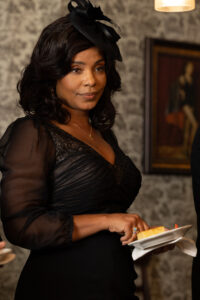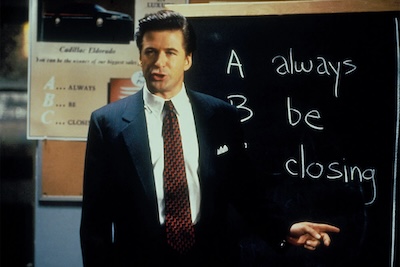If you love films and television that chronicle the ups and downs of friendships throughout the most tumultuous of personal times then you need to watch Tina Mabry’s The Supremes at Earl’s All-You-Can-Eat. It deserves to have its own place in the pantheon of coming-of-age tales, and the three leads–played by Uzo Aduba, Aunjanue Ellis-Taylor, and Sanaa Lathan–are perfection. We love these kinds of stories, because we can see ourselves in the characters even if they are based on specific literary texts, and costume designer Whitney Anne Adams combined the characterizations from the script and the novel to create the foundations of a trio of women who never fail to have each other’s backs.
Adams definitely had her work cut out for her when you realize just how much time we will be spending with these women. We see them as children in 1950 before spending a considerable chunk in the late 1960s, and we see the adult versions of these characters in 1999. Costume designers have to visually telegraph to us who these people are in order to make such a vast story land, and there was a lot that Adams loved about the time periods we wade through.
“I am a big lover of prints and colors,” Adams says. “A lot of my personal wardrobe is from late ’60s patterns and colors, so it was easy and fun to dive into that and use it on camera. I haven’t had a chance to do that very much, so exploring that was very satisfying for me. With the advent of clothing technologies, that really blew up. Fabrics were cheaper, and you could experiment more. The late 90s were a bit of a tough time for fashion, and we have come quite a way in the last 25 years. For these actors, it was interesting for them to explore a different age than the characters in 1999. The actors had some help with their characters since it gave them a time and place.”

We don’t often hear lines devoted to the costumes of characters, but young Clarice tells Odette, ‘Your clothes are virginity insurance’ when she spies her friend in an orange, patterned dress. Having that line in the script informed Adams so much not just on how others see Odette’s wardrobe but also how Odette doesn’t care about what other people think.
“That was my main touchstone for Odette as a whole,” she says with a laugh. “The line is also in the novel, and I read that after I read the script a few times. They are companion pieces to each other, and I pulled every visual reference from the script and the novel and plugged them into a spreadsheet. I had that as a foundation, but that line was a jumping off point. This is a dress that her blind grandmother made for her, so [Odette] doesn’t really care what it looks like. It’s more important to her that her grandmother loves her and she created something for her to wear. Odette is going to wear it with heart and rock it. Her color palette leaned more towards earth tones since she is the grounded one of the group and in her family.
I started with Aunjanue [Ellis-Taylor] since she was the first person to be cast, so I scoured and stalked her on the internet to find every picture that I could find to see what colors and patterns worked best with her and Odette. Because we were fitting the younger cast first, I worked with Kyanna Kee-Kee [Simone] to start, and I found, of those colors, what worked best with her. I then went to find what patterns and fabrics worked best with the idea of that dress.”
Aduba’s Clarice looks like she has dressed for success every moment of her entire life. When we see her as an adult, we pick up on the dark blues, the violets, and the purples. It’s almost as if we can sense the hurt in her marriage, but she can make that looks sophisticated and organized at the same time. With a lot of the women in Mabry’s film, they gain inspirations from their mothers. When Clarice and Richmond have a falling out in their marriage, we notice a change in the styling of Clarice’s clothes, but they always read as authentically Clarice.
“The biggest thing that I took from the book and the script is that Clarice’s mother, Beatrice, shaped who Clarice is as a person as she grew up,” Adams says. “In the book, Beatrice never let her husband see her without makeup and everything was in place, and Clarice is naturally an overachiever ans striving for more. When Beatrice gave birth to her daughter, she was the first Black women to give birth in the hospital, so she wants more for Clarice and that is tied into how she organizes and has so many goals. If you look at her patterns, you will see that they are all very geometric and straight lines, so they are organized too. She is dressing for the job that she wants, and she wants to be seen as an put-together young woman. In the book, as she gets older, I changed her a lot from the book, but I kept the foundation and the essentials the same. When she separates from Richmond in the book, she wears a lot of hippie clothes, but I made them more casual. It fit more with what Uzo [Aduba] was achieving in her performance, so that fit well. I love that she has the most mature patters in the ’60s and that carries over into 1999.”

Lathan’s Barbara Jean projects a lot with her clothing. As an adult, her dresses are cut lower on the top and some (even a black dress worn to a funeral) feature some unexpected sparkle. When we see Barbara Jean as a young girl, her clothing helps her stand out, but then she uses her clothes to hide some of her personal struggles, like with her alcoholism.
“Something that you really can’t bring from the novel’s narration is that Barbara Jean, when we first meet her, is wearing her mother’s shiny, tacky hand-me-downs, but an audience isn’t going to know that in a film unless it’s spoken,” she says. “I can’t dress her in something tacky without the back story. I chose to place her in her mother’s clothes, but they are from the late ’50s or early ’60s, and I took that through-line of her dressing lower cut with her subconsciously thinking of her mom. She probably remembers how her mother got dressed to go out, and she is the trendiest of the three of our lead characters. Barbara Jean is at least aware of what the trends are and that continues to 1999, and she is the most comfortable in her own body. She is dealt the hardest blows in the film, and she dresses herself to help herself feel better. The necklace she wears is a touchstone for her, and she wears it every day as a sort of protector. Having this shell or exterior to show how beautiful she is is almost a diversion so people don’t ask her how things actually are. It’s a distraction for everything she is going through.”
Since Supremes covers such a large amount of time, I knew that Adams might have a few items to snag for her own closet. I want Barbara Jean’s fetching pajamas and Richie’s green letterman cardigan, but we both want Minnie’s green sequined dress.
“In the book and the script, she has her fortunetelling, and I wanted to play that up,” Adams says. “She is such a fun character. I found that dress in an Etsy shop, and the seller had it in her closet for twenty years. She didn’t know where it came from, and Donna [Biscoe] walked right into it. No alterations–it was kismet. I couldn’t rock Odette’s orange dress, but I want it. It makes me so happy.”
The Supremes at Earl’s All-You-Can-Eat is streaming now on Hulu and Disney+.









